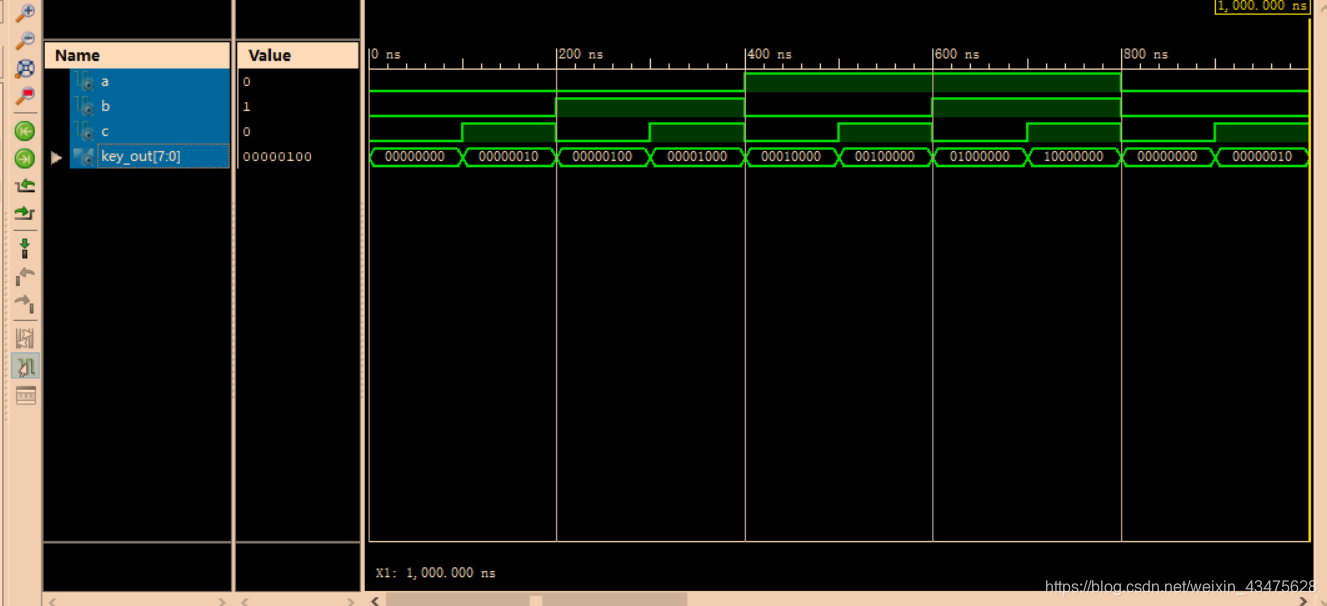学过数电应该都知道有38译码器这个东西
就是通过3个输入端,控制8个输出端的状态。2.^3正好是8位。
下面附上代码:
//ujs-lili
module my3_8(a,b,c,out);
input a,b,c;
output [7:0]out;//表示位宽为8bit的输出信号
reg [7:0]out;//或者直接output reg [7:0]out;
always@(a,b,c) //这个跟vhdl中的process类似,a,b,c是敏感变量,只有有变化,就会执行always块中的内容
begin
case({a,b,c}) //注意case里边是{},这个和vhdl中的&相类似,原来a,b,c是bit,现在是合起来3bit
3'b000: out = 8'b0000_0001;
3'b001: out = 8'b0000_0010;
3'b010: out = 8'b0000_0100;
3'b011: out = 8'b0000_1000; //always中的数必须是reg(寄存器)定义的,如果没有reg out那句话,就会报错。
3'b100: out = 8'b0001_0000; //Procedural assignment to a non-register out is not permitted, left-hand side
3'b101: out = 8'b0010_0000;
3'b110: out = 8'b0100_0000;
3'b111: out = 8'b1000_0000;
endcase
end
endmodule
这个程序很简单,但是从中能学到几点:
1.这个程序一开始报错,主要是always中的变量一定要是reg型的。
2.用{ }可以把几个bit的变量合成一个
下面做一个ise的仿真:
//ujs-lili
`timescale 1ns / 1ps //1ns是单位,1ps是精度
module my3_8_tb;
// Inputs
reg a;
reg b;//激励信号
reg c;
// Outputs
wire [7:0] out; //输出信号。
// Instantiate the Unit Under Test (UUT)
my3_8 uut (
.a(a), //信号和端口的连接
.b(b),
.c(c),
.out(out)
);
initial begin
// Initialize Inputs
a = 0;b = 0;c = 0;
// Wait 100 ns for global reset to finish
#100;
a = 0;b = 0;c = 0;
#100;
a = 0;b = 0;c = 1;
#100;
a = 0;b = 1;c = 0;
#100;
a = 0;b = 1;c = 1;
#100;
a = 1;b = 0;c = 0;
#100;
a = 1;b = 0;c = 1;
#100;
a = 1;b = 1;c = 0;
#100;
a = 1;b = 1;c = 1;
#100;
$stop;
// Add stimulus here
end
endmodule
那么这个仿真自己输入的仅仅是initial begin那段:其他都是ise自己给的。
最终得到仿真波形:

--ujs-lili
entity my3_8 is
port(a,b,c:in std_logic;
key_out:out std_logic_vector(7 downto 0));
end my3_8;
architecture Behavioral of my3_8 is
begin
process(a,b,c)
variable d :std_logic_vector(2 downto 0);
begin
d := a&b&c;
case (d) is
when "000" => key_out <= "00000000" ;
when "001" => key_out <= "00000010" ;
when "010" => key_out <= "00000100" ;
when "011" => key_out <= "00001000" ;
when "100" => key_out <= "00010000" ;
when "101" => key_out <= "00100000" ;
when "110" => key_out <= "01000000" ;
when "111" => key_out <= "10000000" ;
when others => null;
end case ;
end process;
end Behavioral;
这个程序很简单,但是有过报错:
1.when others => null; 没有写,少掉了=>
2.d是一个变量,所有:=
3.end process后边的;
4.其实可以更简单,直接把a,b,c定义成d in std_logic_vecrtor(2 downto 0)
仿真程序:
--ujs-lili
LIBRARY ieee;
USE ieee.std_logic_1164.ALL;
-- Uncomment the following library declaration if using
-- arithmetic functions with Signed or Unsigned values
--USE ieee.numeric_std.ALL;
ENTITY my3_8_tb IS
END my3_8_tb;
ARCHITECTURE behavior OF my3_8_tb IS
-- Component Declaration for the Unit Under Test (UUT)
COMPONENT my3_8
PORT(
a : IN std_logic;
b : IN std_logic;
c : IN std_logic;
key_out : OUT std_logic_vector(7 downto 0)
);
END COMPONENT;
--Inputs
signal a : std_logic := '0';
signal b : std_logic := '0';
signal c : std_logic := '0';
--Outputs
signal key_out : std_logic_vector(7 downto 0);
-- No clocks detected in port list. Replace <clock> below with
-- appropriate port name
BEGIN
-- Instantiate the Unit Under Test (UUT)
uut: my3_8 PORT MAP (
a => a,
b => b,
c => c,
key_out => key_out
);
process
begin
a <= '0';b <= '0';c <= '0';
wait for 100 ns;
a <= '0';b <= '0';c <= '1';
wait for 100 ns;
a <= '0';b <= '1';c <= '0';
wait for 100 ns;
a <= '0';b <= '1';c <= '1';
wait for 100 ns;
a <= '1';b <= '0';c <= '0';
wait for 100 ns;
a <= '1';b <= '0';c <= '1';
wait for 100 ns;
a <= '1';b <= '1';c <= '0';
wait for 100 ns;
a <= '1';b <= '1';c <= '1';
wait for 100 ns;
end process;
END;
最后的结果和Verilog的一样:

